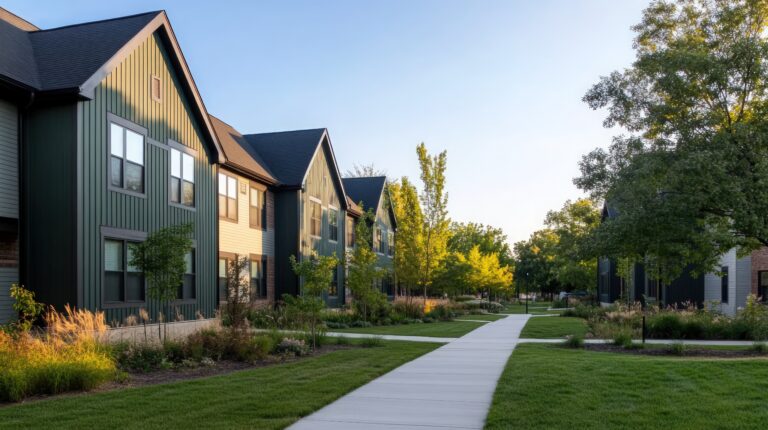Western governors try to boost housing as population grows
By D. Dowd Muska | October 31, 2025
What do Houston, Los Angeles, San Antonio, Fort Worth, Phoenix, Seattle, San Jose and Las Vegas have in common? U.S. Census Bureau data show that each made the list of the 15 cities “with the largest numeric population gains between 2023 and 2024.” Among the states, Texas notched the biggest “numeric increase in the country, adding nearly 563,000 people,” ranking it behind only Florida in percentage growth, with Utah (4), Nevada (6), Idaho (7) and Arizona (10) also high-achievers in proportional expansion.
Americans are moving to states bisected by, or west of, the 100th Meridian – in huge numbers. But will there continue to be enough homes at affordable prices for all the newcomers?
The Western Governors’ Association (WGA) hopes so. However, a formidable obstacle course stands in the way. The organization’s report, “Building Resilient and Affordable New Developments in the West,” warns that as “more people have discovered the beauty, opportunity, and promise of our region, we have seen mounting challenges and pressure points” with “housing availability and affordability.”
The WGA’s membership includes the chief executives of 19 states, with the governors of American Samoa, the Northern Mariana Islands and Guam included for good measure. The politicians’ constituents number over 122 million, comprising more than a third of the U.S. population. The area is far from monochromatic – it includes some of the nation’s bluest (California, Oregon, New Mexico) and reddest (Idaho, Utah, Oklahoma) states. Eleven of its governors are Republican, eight are Democratic.
“BRAND West” was the initiative of Governor Michelle Lujan Grisham, D-New Mexico, who recently concluded a year-long term as WGA chair. The report’s greatest strength is its focus on pro-housing innovations already implemented throughout the region:
- Several states “have … passed legislation to establish by-right processes, which enable housing projects to proceed without discretionary review and approval if they comply with all applicable laws and regulations.” California andHawaii are examples of states that have greenlit “multifamily housing by right on commercially zoned land,” with Arizona adopting “certain components” of the concept.
- Modular housing, J.P. Morgan & Co. believes, can “reduce some of the waste generated by on-site construction,” “allow for more precise control over the project schedule,” and even “reduce labor costs.” The Center for American Progress, Urban Institute and National Renewable Energy Laboratory agree. As does the Colorado Legislature. WGA notes that Washington, Oregon and Idaho “have a reciprocity agreement” that eases the industry’s red-tape burden. PerThe Oregonian, the pact “allows inspectors employed by the state that houses the home-manufacturing facility to do the inspection on behalf of the state where the structure will be delivered.”
- Co-living “helps decrease the costs of adaptive reuse for office buildings, which may make it a more feasible option to address housing supply constraints.” Washington and Oregon “have legalized micro-units where multifamily housing is permitted by zoning code,” and Hawaii “has prohibited any requirements more stringent than the International Building Code for adaptive reuse and has allowed for adaptive reuse of vacant commercial buildings.” Salt Lake City “has waived certain requirements to allow for adaptive reuse.”
- Arizona’s “model suite of legislation” included “‘shot clocks’ for municipal zoning application reviews,” mandates that “cities with populations over 150,000 … establish objective standards allowing multifamily or adaptive reuse in up to 10% of existing commercial, office, and mixed-use buildings without discretionary approvals like conditional use permits or rezoning,” and legalization of accessory dwelling units (ADUs) “in cities over 75,000 in population.”
- Big Sky Country’s “trailblazing housing, zoning reform and land use bills” – an overhaul considered the “Montana Miracle” by many – was the product of Republican Gov. Greg Gianforte’s “focus on consensus-building, free market solutions and streamlining regulations.” Among other reforms, the legislative package allowed “duplexes to be built wherever there is single-family housing for municipalities of more than 5,000 residents,” sanctioned “multifamily residential and mixed-use buildings in areas zoned for commercial use,” freed ADUs from “regulations such as parking minimums,” and eliminated “design review by external boards.”

Unfortunately, “BRAND West” stumbles badly when it asks Congress and the Trump administration for succor. Of its 31 “Recommendations for Federal Action,” 17 seek the enhancement and/or expansion of direct or indirect federal subsidies. WGA wants more revenue for the PRO Housing Program; creation of “a tax credit for developing and preserving single-family housing in low-income communities”; “adequate appropriations for housing block grants to state and local governments; and a “tax incentive, to preserve and rehabilitate the existing housing stock.”
It also calls for reauthorization of “Opportunity Zones”; improved “educational opportunities for first-time homebuyers”; a requirement that “HUD and other federal agencies … provide technical assistance, capacity-building and data collection and reporting resources for housing”; and “the expansion of education and skills training opportunities for the skilled construction workforce, including apprenticeships and career and technical education.” With the national debt soaring toward $40 trillion, WGA’s costly wish list is dead on arrival in Washington, D.C.
Even if the feds had the money, there’s already quite enough national micromanagement of local housing markets. To its credit, “BRAND West” does seek some regulatory relief, such as exemptions to Davis-Bacon wage requirements (a “cost without a reward”) and a “revisit” of the National Environmental Policy Act (a “clear, consistent, focused, and effective review of the NEPA processes applicable to infill housing development is essential”).
But the report is far too timid on the issue of land control, calling merely for a streamlining of “the process of transferring appropriate federal properties to states, communities, and developers” and “legislation to allow agencies beyond the U.S. Forest Service to lease certain federal lands for affordable housing used by federal employees and the local workforce.” The West is getting a lot of things right on the housing front. But more can be done. And given its empty coffers, begging D.C. for largesse is profoundly unwise.
